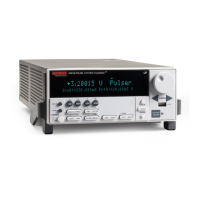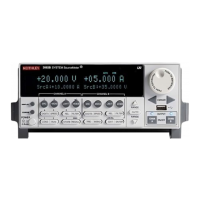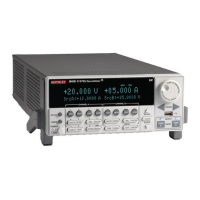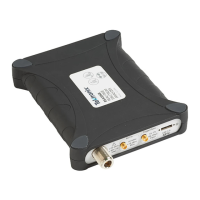Connections for pulser operation
Pulser measurements must be made using 4-wire (Kelvin) connections. Refer to 4-wire remote
sensing connections (on page 4-10) for connection diagrams.
When making pulser measurements, the allowed maximum total inductance is 3 µH. The open areas
between FORCE leads can introduce inductance. To minimize this inductance, jumper the FORCE
connection shields at the device under test (DUT). The FORCE connection shields are jumpered
inside the 2601B-P-INT, so external jumpers are not needed at the instrument.
The signal present at the FORCE terminals is affected by the total inductance in the test circuit. The
signal present at the SENSE terminals is only affected by the inductance beyond the Kelvin
connection points. Take this into consideration when setting the voltage protection levels.
Keithley Instruments offers several low-inductance cable options that are optimized for
pulser applications:
• 2601B-PULSE-CA1 50 Ω BNC-to-BNC cable kit: A set of two 1.2 m BNC-to-BNC cables and
one 1.2 m cable assembly. Use the cables to make the SENSE HI and SENSE LO connections.
Use the cable assembly to make the FORCE HI and FORCE LO connections. On the end
intended for connection to the device under test (DUT), the shields on the cable kit are jumpered
to reduce loop inductance.
• 2601B-PULSE-CA2 50 Ω BNC-to-BNC coaxial cables: A set of two 3 m cables that are used to
make the SENSE HI and SENSE LO connections.
• 2601B-PULSE-CA3 15 Ω BNC-to-BNC cable kit: A set of two 3 m cables that are used to
make the FORCE HI and FORCE LO connections. On the end intended for connection to the
DUT, the shields are jumpered to remove loop inductance. The 2601B-PULSE-CA2 must be used
for the SENSE connections. This cable kit has lower inductance per meter than the
2601B-PULSE-CA1.
Contact check connections
The contact check function prevents measurement errors due to excessive resistance in the force or
sense leads when 4-wire remote sensing is used. Potential sources for this resistance include poor
contact at the device under test (DUT), failing relay contacts on a switching card, and wires that are
too long or thin. To use contact check, the current limit must be at least 1 mA (this allows enough
current to flow when performing the test), and the source-measure unit (SMU) must not be in High-Z
output-off mode.

